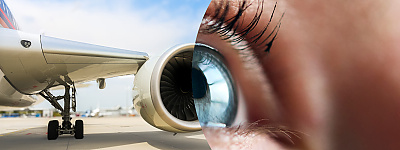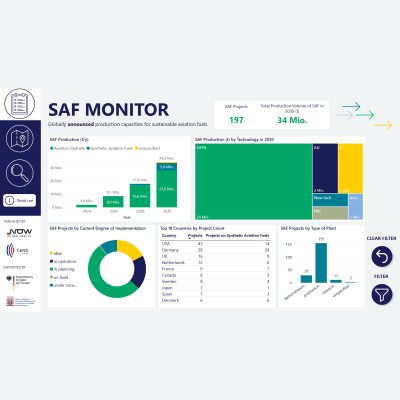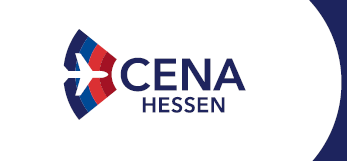The CENA SAF Outlook 2025-2030 provides a comprehensive analysis of the global production development of SAF. The primary focus is on the projected production capacity of SAF by 2030 and the potential for supply shortfalls.

CENA SAF-Outlook
Analysis of the global production of sustainable aviation fuel (SAF)
Overview of the results:
- Announcement for 2030: Global production volume of around 35 million tonnes of SAF, of which around 0.4 million tonnes from Germany
- HEFA share of around 70 % worldwide in 2030
- Production sites in 2030 mainly in North America, Europe and Asia
- Realistic fulfillment of the European SAF quota in 2025 and 2030 (mainly from biogenic processes)
- Fulfillment of the e-SAF quota not assured, dependent on several major projects
- Announced purchase volumes in the EU for 2030 at 0.5 million tonnes
- As of December 2024: 265 active SAF projects worldwide, 31 of which are in Germany
Stay up to date on developments in the SAF market.
Register here for updates on the CENA SAF Outlook.

CENA SAF-Outlook 2025-2030 (EN)
Volumes, Technologies and Markets for Sustainable Aviation Fuels
23.06.2025 download (PDF 2,87 MIB )
Sustainable aviation fuels (SAF) are essential for the Defossilization of aviation. Since 2025, binding Blending quotas for SAF have been in force in the EU, as defined by the ReFuelEU Aviation Regulation. However, despite regulatory requirements, only limited quantities are currently available.
The CENA SAF Outlook 2025-2030 offers a comprehensive overview of global production volumes announced until 2030, along with an in-depth analysis of the technologies used employed, the current status of the respective projects, and the sufficiency of the planned capacities to meet EU quotas. The analysis is based on publicly available information, supplemented by our own research and specially provided company data.
Around 35 million tonnes of SAF announced globally for 2030
million tonnes of SAF
in 2024
million tonnes of SAF
in 2026
million tonnes of SAF
in 2028
million tonnes of SAF
in 2030
The list of the largest SAF production locations in 2030 is led by North America with around 16 million tonnes, followed by Europe and Asia with 8 million tonnes each. Compared to the CENA SAF Outlook 2024, the announced production volume for 2030 has increased by 5 million tonnes. Asia (+ 3 million tonnes) as well as North and South America (+ 2 million tonnes each) have seen significant increases. In Europe, the SAF production announced for 2030 has decreased by 1.5 million tonnes - mainly due to changes in the announcements of major projects in Spain, the Netherlands, Austria and Germany. The SAF production announced for 2030 in Germany is around 420,000 tonnes.
% HEFA process
for the production of SAF in 2030
In 2024, over 90 % of SAF worldwide was produced using the HEFA process. This share is projected to decrease to around 70 % by 2030, driven by the increasing production volume from AtJ and PtL processes. Overall, there will be significant global interest in biogenic processes for SAF production until 2030. By that time, synthetic fuels will account for slightly less than a quarter of the announced SAF production. The rest is covered by alternative processes.
Most SAF projects still at an early stage of development
active projects worldwide
plants in operation
As of December 31, 2024, 265 active projects and plans for the production of SAF had been identified in 45 countries worldwide. In 2024, 49 SAF plants were in operation worldwide, including 31 industrial production plants with an announced annual SAF production of more than 10,000 tonnes. The 18 other projects are pilot or research plants with production volumes of less than 10,000 tonnes per year.
Worldwide, more than half of the projects are still at an early stage of development, either in the idea or planning phase. Of the 35 million tonnes of SAF production that have been announced for 2030, approximately one third (13.1 million tonnes) are from projects with a high development status (in operation or under construction / in commissioning). Just over half of the volume (19.5 million tonnes) is associated with planned projects that have not yet been realized.
Fulfillment of the SAF quota from HEFA realistic - Fulfillment of the e-SAF quota not assured
The EU's ReFuelEU Aviation Regulation, effective since 2025, has mandated fuel suppliers to increase the provision of sustainable aviation fuels. The quota will begin at 2 % and gradually rise to 70 % by 2050, with at least 35 % required to come from non-biogenic, i.e., synthetic sources (e-SAF).
By 2030, the quota increases to 6 % of Kerosene consumption in the EU, which corresponds to a calculated demand of around 3.1 million tonnes of SAF. Projects with a high probability of implementation are expected to produce approximately 3.8 million tonnes of SAF, covering the forecast demand from the EU quota.
Overall, production capacities in the EU could increase to up to 6.3 million tonnes in 2030. The majority of these quantities can be attributed to HEFA-SAF, a biogenic process with a high level of technological maturity. Fulfilling the SAF quota with biogenic SAF therefore appears realistic.
More critical is the achievement of the e-SAF sub-quota of 1.2 % in 2030. This corresponds to a required e-SAF volume of around 620,000 tonnes. For the year 2030, only 72,000 tonnes of e-SAF from projects with a high development status are expected in the EU, while an additional 1.4 million tonnes of potential capacity is in the early planning stages or without investment decisions. Fulfillment of the e-SAF quota is therefore not guaranteed, and further action is necessary to ensure satisfactory e-SAF production in the EU.
Demand for SAF is not sufficient - offtake agreements fall short of demand
0.5 million tonnes of announced purchase volumes for 2030 significantly below the SAF requirement of 3.1 million tonnes
At 500,000 tonnes, the purchase volumes announced by airlines to date for 2030 are far below the requirement for the EU SAF quota of 3.1 million tonnes. This corresponds to only around one sixth of the expected demand.
While some airlines have already made progress in the use of SAF, their commitment is not yet sufficient. The largest SAF customers in Europe in 2023 included Air France-KLM, the DHL Group and the International Airlines Group (IAG). Their SAF share of fuel used in 2023 was between 0.68 % and 3.27 %. This indicates that SAF remains a pioneer product in terms of total volume of fossil Kerosene. Most of the purchase volumes announced to date do not constitute binding commitments. They are mostly declarations of intent that signal a fundamental willingness to purchase SAF, but do not give producers and investors any long-term planning security.
In the voluntary market, however, initial successes are being seen, particularly in the air freight sector. The potential for business customers in the B2B sector to reduce their indirect emissions (Scope 3) through the use of SAF is generating a certain level of demand. This option is also available for corporate customers in the passenger segment. The situation is different for private travelers: In this case, the willingness to pay for SAF-related additional costs has been notably lower.

SAF-Monitor
The interactive data visualization shows the SAF projects announced worldwide based on the CENA SAF Outlook.
Measures for the SAF market ramp-up
To advance sustainable aviation fuels from a pilot product to a staple of climate-friendly air traffic, targeted measures are essential at the national and European levels. Investments in SAF plants are associated with a high degree of risk. This underscores the significance of stable framework conditions and economic incentives:
- Tax credits and accelerated depreciation
- Guarantee programs
- Grandfathering rights for the first plants
- Price and/or purchase guarantees, such as in the UK (“Revenue Assurance Mechanism”)
- Clear and long-term legal foundations
- Development of effective promotion and import strategies
- Centralized SAF procurement, such as in Singapore (“Buyers' Club”)
- Simplified approval procedures and rapid path qualification of new technologies
- Self-commitment of public bodies to CO₂-neutral business trips and use of SAF, e.g. for government flights

Dr. Sabine Leiser
Market Research Sustainable Aviation Fuels
Department
Centre of Competence for Climate, Environment and Noise Protection in Aviation (CENA Hessen)
